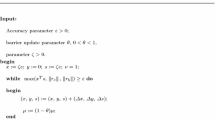Abstract
The interior point algorithm for a linear programming problem is considered. The algorithm consists of two stages. At the first stage, we enter into the domain of feasible solutions for given constraints. The second stage lies in optimization over the feasible domain. Entering into the feasible domain is represented as an extended linear programming problem by adding only one new variable. The main goal of this paper is to provide a theoretical justification for the process of entering into the feasible domain under the assumption that the extended problem is nondegenerate.
Similar content being viewed by others
References
Dikin, I.I., Iterative Solution of Linear and Quadratic Programming Problems, Dokl. Akad. Nauk SSSR, 1967, vol. 174, no. 4, pp. 747–748.
Dikin, I.I., Convergence of One Iterative Process, Upr. Sistemy, 1974, no. 12, pp. 54–60.
Dikin, I.I., Metod vnutrennikh tochek v lineinom i nelineinom programmirovanii (Internal Point Method in Linear and Nonlinear Programming), Moscow: KRASAND, 2010.
Dikin, I.I. and Zorkaltsev, V.I., Iterativnoe reshenie zadach matematicheskogo programmirovaniya: algoritmy, metody vnutrennikh tochek (Iterated Solution of Mathematical Programming Problems: Interior Point Algorithms), Novosibirsk: Nauka, 1980.
Evtushenko, Yu.G., Metody resheniya ekstremal’nykh zadach i ikh primeneniya v sistemakh optimizatsii (Solution Methods for Extremal Problems and Their Application in Optimization Systems), Moscow: Nauka, 1982.
Eremin, I.I., Mazurov, V.D., and Astaf’ev, N.N., Nesobstvennye zadachi lineinogo i vypuklogo programmirovaniya (Improper Problems of Linear and Convex Programming), Moscow: Nauka, 1983.
Eremin, I.I., Teoriya lineinoi optimizatsii (Theory of Linear Optimization), Yekaterinburg: Ross. Akad. Nauk, 1998.
Zorkaltsev, V.I., Iterative Algorithm for Solving Linear Programming Problem, in Algorithms and Programs for Solving Problems of Linear Algebra and Mathematical Programming, Irkutsk: Sibirsk. Energ. Inst., 1998
Zorkaltsev, V.I., Otnositel’no vnutrennyaya tochka optimal’nykh reshenii (A Relatively Interior Point of Optimal Solutions), Syktyvkar: Akad. Nauk SSSR, 1984.
Zorkaltsev, V.I., Metody prognozirovaniya i analiza effektivnosti funktsionirovaniya sistemy toplivosnabzheniya (Methods of Prediction and Efficiency Analysis of Fuel Supply Systems), Moscow: Nauka, 1988.
Zorkaltsev, V.I., Justification of the Class of Projective Algorithms, Inkutsk: Inst. Sist. Energetiki, 1995.
Zorkaltsev, V.I., Substantiation of Interior Point Algorithms, Comput. Math. Math. Phys., 1999, vol. 39, no. 2, pp. 198–211.
Zorkaltsev, V.I., A Class of Interior Point Algorithms, Zh. Vych. Mat. Mat. Fiz., 2004, vol. 49, no. 12, pp. 1–18.
Zorkaltsev, V.I. and Kiseleva, M.A., Sistemy lineinykh neravenstv (Systems of Linear Inequalities), Irkutsk: Irkutsk. Gos. Univ., 2007.
Rockafellar, R.T., Convex Analysis, Princeton: Princeton Univ. Press, 1970. Translated under the title Vypuklyi analiz, Moscow: Mir, 1973.
Filatov, A.Yu., Development of Interior Point Algorithms and Their Applications to Systems of Inequalities, Cand. Sci. (Phys.–Math.) Dissertation, Irkutsk, Irkutsk State University, 2001.
Barnes, E.R., A Variation on Karmarkar’s Algorithm for Solving Linear Problems, IBM Boston Research Centre, 1986.
Karmarkar, N.A., New Polynomical Time Algorithm for Linear Programming, Combinatorica, 1984, no. 4, pp. 373–395.
Mitchell, J.E. and Todd M.J., On the Relations in the Affine and Projective Variant of Karmarkar’s Linear Programming Algorithm: Technical Report, Ithaca: School of Operat. Res. Industr. Eng., College of Engineering, Cornell Univ., 1986, no. 4.
Vanderbey, R.J., Mechetov, M.S., and Freedman, B.A., A Modification of Karmarkar’s Linear Programming Algorithm, Holmdel: AT&T Bell Laboratories, 1985.
Wei Zi–Luan, An Interior Point Method for Linear Programming, J. Comput. Math., 1987, vol. 5, no. 4, pp. 342–351.
Tsuchiya, T., Global Convergence of the Affine Scaling Methods for Degenerate Linear Programming Problems, Research Memorandum no. 373, Tokyo: Inst. Statistical Mathematics, 1990.
Author information
Authors and Affiliations
Corresponding author
Additional information
Russian Text © V.I. Zorkaltsev, 2016, published in Upravlenie Bol’shimi Sistemami, 2016, No. 59, pp. 23–44.
Rights and permissions
About this article
Cite this article
Zorkaltsev, V.I. Entering into the Domain of Feasible Solutions Using Interior Point Method. Autom Remote Control 80, 348–361 (2019). https://doi.org/10.1134/S0005117919020127
Received:
Revised:
Accepted:
Published:
Issue Date:
DOI: https://doi.org/10.1134/S0005117919020127



